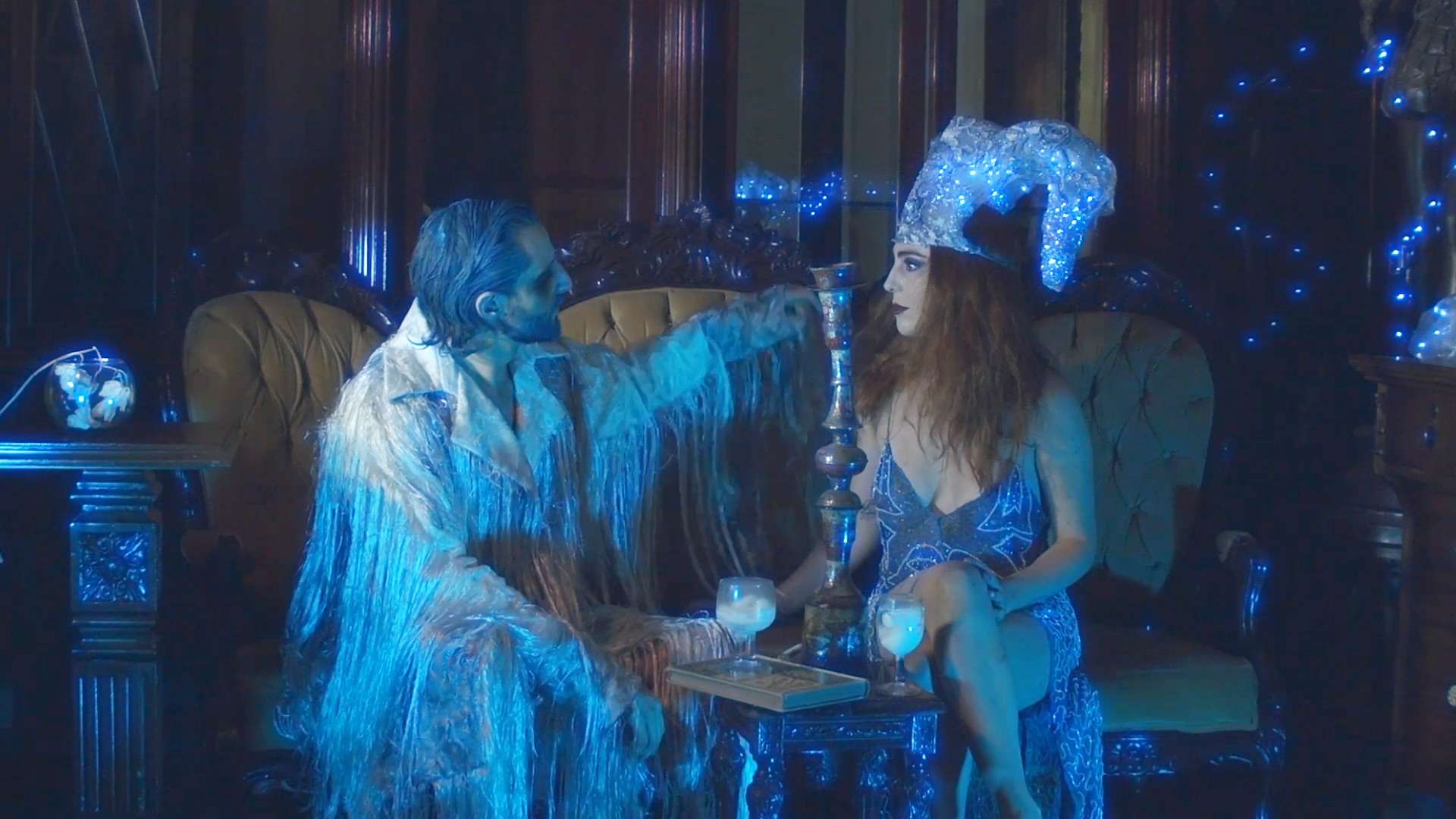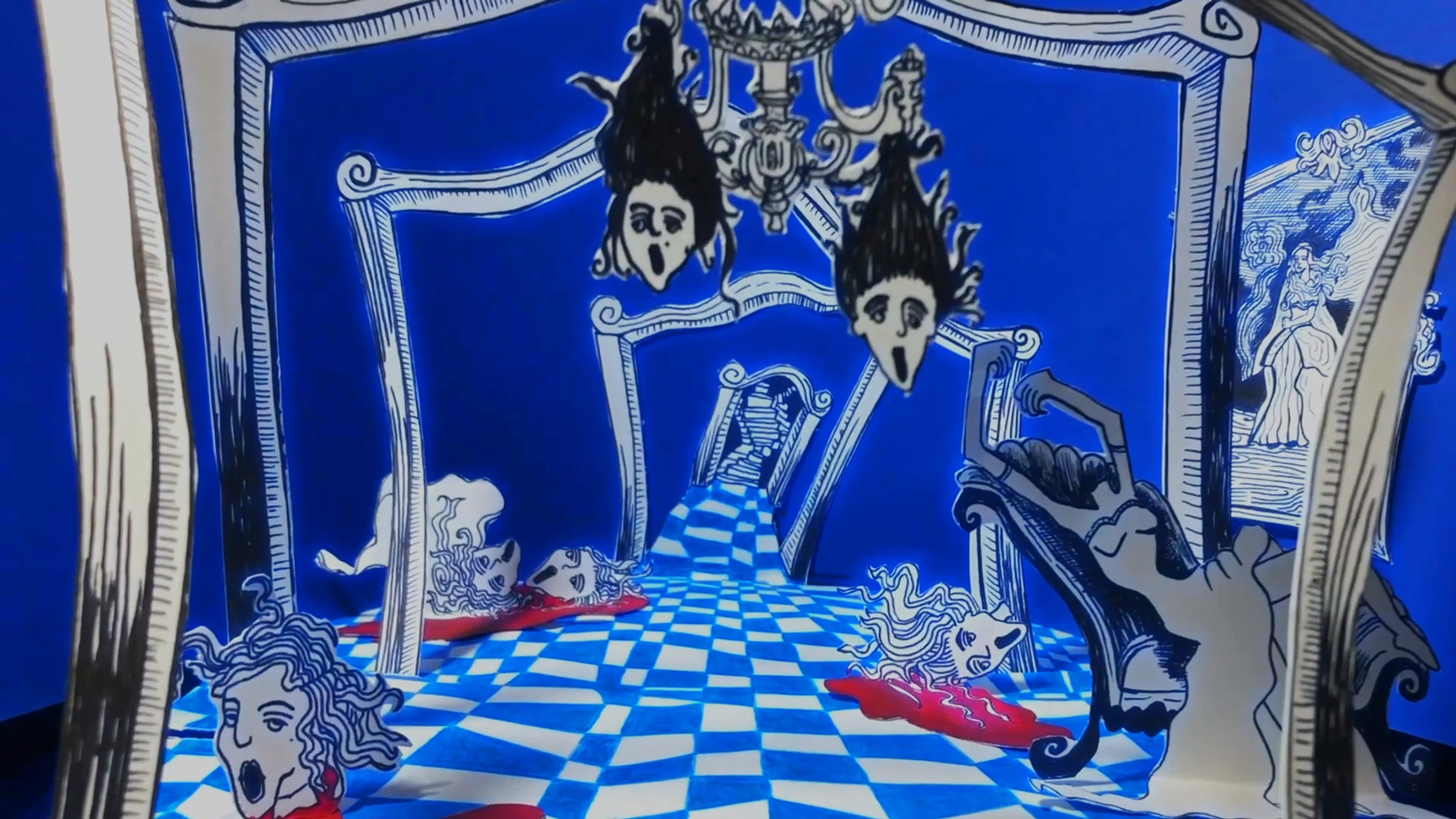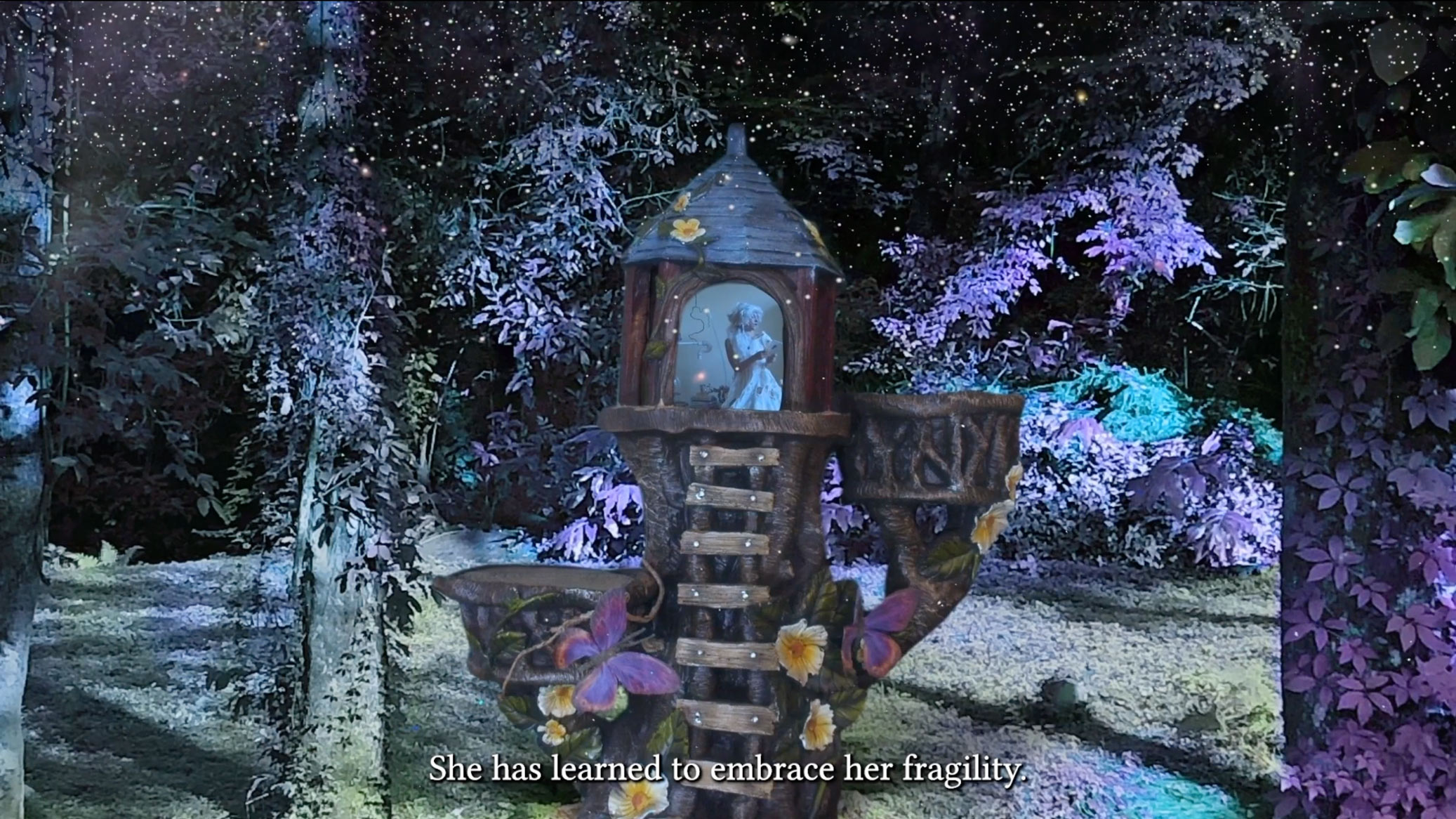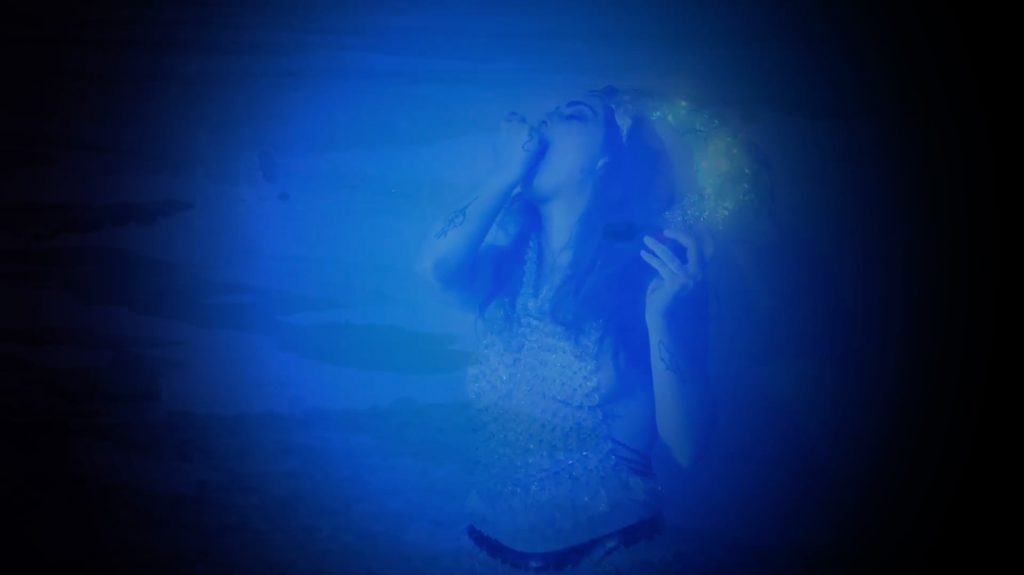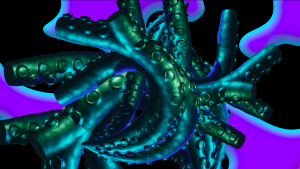with JOURNEY TO THE UNDERWORLD
a video by PAOLA ESTRELLA
Read this essay in French — Read this essay in Russian — Read this essay in Spanish
Abstract: Is there love without violence? Luce deLire puts the use (of private property) back into abuse (between intimate partners) and identifies toxic possessiveness and control among intimate partners as symptoms of capitalism. She argues that most of contemporary pop culture trains us to take toxicity as the paradigm of romantic love—a condition which finds its continuation in actual violence between intimate partners. Unlearning toxicity means to detox from pop culture. Drawing on ancient lesbian poet Sappho, she suggests an alternative, anti-capitalistic version of romantic love: the indeterminate sublime.
This is the second part of Luce deLire, “Lessons in Love I: On Revolutionary Flirting,” in Stillpoint Magazine Issue 009: TENDER (2021).
I’m just trying to help you
(But you don’t trust me) …
– Alice Glass, Fair Game
“There is nothing more romantic than unnecessary drama!” Some night, some bar, some city in northern Europe (Berlin). György is clear: “What would love be without sacrifice? And what without the drama surrounding it?” Sounds toxic to me. I suggest a distinction: how about if we distinguish negative from positive sacrifice? What I mean is that sometimes we give up on things and on ourselves for the sake of someone or something such that we don’t lose anything, but merely transform into something we anyway wanted to become. And sometimes we give up on things that are then lacking: sometimes the sacrifice functions in the registers of private property, taking away something that used to be ours. And sometimes sacrifice functions in the registers of hospitality, sharing something for the sake of mutual benefit. Sometimes, that is, we dedicate our love and affection to a particular person and are robbed of our friends, our family, our time for ourselves, and the things we like to do. And sometimes we dedicate love and affection to a particular person such that our other interests and relations benefit from it. Sometimes, that is, we share ourselves, and sometimes we are taken, possessed. Sometimes the sacrifice is romantic, and sometimes the sacrifice is toxic. The romantic sacrifice enables the person sacrificing to flourish, while the toxic sacrifice disables that person to do things, takes from them in the manner of private property.
“Just like Romeo and Juliet!” György exclaims. “Both Romeo and Juliet give their lives for each other in an act of absolute sharing!” True, Romeo and Juliet is probably the paradigmatic case of romantic love in the Western world. The thrust of the story is that two teenage children of enemy clans in sixteenth century Verona, Italy, fall in love with each other and end up committing suicide due to unfortunate circumstances, miscommunication, and political oppression. This instance of sacrifice is still taken to be the paradigmatic form of romantic love to the present day: absolute dedication, giving everything for one another. “But let’s look at the text more closely, why exactly do they kill themselves?” While we both bend over my broken display by candlelight, scrolling through a digitized text from 350 years ago, my hunch turns out to be correct: after mistaking the sleeping Juliet for the dead Juliet, Romeo sacrifices himself out of jealousy.1 He imagines that death was making Juliet his lover. Romeo’s sacrifice is thus not at all a gift meant to benefit Juliet. Rather, it is an act of rivalry against another “lover”—death. It is an act of hostility more than an act of love.
The bartender, whom I happen to know from another time and space, treats us to a round of shots, with the words: “Once you are here already … !” “Cheers!” we respond and turn back to the text.
“What does Juliet have to say when it’s her turn to die?” I ask. Her answer: “Yea, noise? Then I’ll be brief. O happy dagger! This [body] is thy sheath; there rest and let me die.” Shakespeare writes the female version of romantic death such that its protagonist does not even have time to tell us why she has to die. Her existence evaporates, pulverized in between a band of boys—oppressive family structures, the oncoming persecutors, a jealous husband, and a patriarchal poet (Shakespeare). Looks like a toxic sacrifice to me. György agrees: “For love, something has to die—even if it’s just a fucking flower.”
How come the story of a double teenage suicide, the one driven by jealousy, the other erased by patriarchal oppression, is still counted as the pinnacle of romantic love? What is romantic love such that this tragedy could become a positive paradigmatic case?
In her famous “fragment 16,” arch-witness of lesbian love Sappho (ca. 630–570 BCE) offers a clue to solve this question.2 To Sappho, seeing the one you love and watching a battle unfold are not opposed to one another; they are different values on a spectrum of aesthetic experience. Sappho’s point is not that watching a battle is not an aesthetic experience. Her point is that looking at her lover gives her a stronger aesthetic experience than watching people kill each other in battle. What then is that aesthetic experience that covers both love and war and romantic bliss and murderous chaos? My suggestion: love and war are connected by an experience of infinity without direct involvement.
Picking up on a long tradition of philosophical aesthetics, I call the experience of such infinity the sublime. I say that this experience approaches infinity because that thing which we observe literally has no limit, or at least that limit cannot be determined. New York City seen from the Empire State Building stretches beyond the horizon, and we can easily imagine it going on forever. Both love and war, affection and violence, can cause this experience: witnessing the overwhelming infinity of violence or the promise thereof in an army on the one hand, being confronted with the infinite beauty of a lover on the other hand. Whenever lovers gaze into each other’s eyes indefinitely or talk on and on and on about nothing in particular, they experience what I call the romantic sublime. And yet, the romantic sublime is not the paradigmatic case of romantic love in Western societies. The point of Romeo and Juliet is not that the protagonists are captivated by each other’s eyes for an eternity, but that facing the impossibility of their union, they both commit suicide. While to Sappho, our confrontation with infinity is closer or more intimate in love than in war, in Shakespeare, a certain dimension of violent love takes center stage. Unlike Sappho’s romantic sublime, Shakespeare’s is a toxic sublime—a confrontation with the eternity (as infinite duration) of violence (suicide, death), coupled with the infinity of love (as a desire that literally transcends life).
The erotics of toxicity consists in the sublime experience of terrors kept at bay without the facing of their consequences. Just like observing a storm through a glass window, red flags may be fun to watch until they become batons: allegedly, we are not involved, we just watch the disaster unfold, and we enjoy the spectacle. That’s what happens to us in Romeo and Juliet: we are drawn towards the drama by virtue of not being a part of it. If it were our lover, our daughter who died, we would kick and scream and feel awful. Yet from behind the fourth wall, comfortably seated and protected from the effects of the unfolding catastrophe, we can enjoy the show. And while the drama unfolds and the end is not yet in sight, that catastrophe appears to be infinite, a bottomless pit of misery, getting worse and worse. Love in its dramatized, publicized form is more often than not geared exactly towards the toxic sublime in this sense, with Romeo and Juliet as but one example. And in this way, we are trained, habituated to experience toxicity as romantic love.
The toxic sublime, however, is not restricted to fictional scenarios. It is part of the mechanics of actual toxic relationships just as it is constitutive of substance abuse. Aesthetically speaking, the closer you get to the unfolding spectacle without getting involved, the more intense the enjoyment will become (tourism to dangerous places and zoos follow the same logic—think Tiger King). Sex maximizes this proximity to the dangerous reality. Yet the closer you get, the more likely it becomes that the fourth wall is broken, that you become a participant in the spectacle rather than a spectator, whether you are aware of being subjected to real violence already or not. Watching Romeo and Juliet may seem like safe business. But get in a little closer on the action … At what point does your possessive partner’s unwillingness to seek professional help for anger issues or depression or anxieties become an emotional prison, a physical threat? When does general emotional instability and the acting out of unfortunate childhood experiences transform from needy dependence into a violent claim to ownership?
My point is that this ostensibly distanced, aesthetic experience of violence is itself a constitutive aspect of any toxic relationship, be it with romantic partners, parents, or addictive substances: we think that we are further away from it than we actually are. This is what the erotics of toxicity consists of: an emotional vertigo effect. On the one hand, the denial of the reality of violence allows for a particular aesthetic experience—the toxic sublime. On the other hand, that same denial allows the toxic relation to flourish because it generates the illusion that one remains outside of it, in control, a spectator, even though the red line into an emotional war zone may have been crossed long ago. Once enthralled by the toxic relationship, people are often too captivated by the sheer interminable (infinite) onslaught of fights, arguments, and emergencies to even consider breaking up, seeking help, or understanding themselves as being subject to violence in the first place. This is the magic of the toxic sublime: your alienation from your own situation is the fuel that keeps it going. At times it enables you to experience a strange kind of joy in the discursive attention of therapists and friends, a sense of gratification about the interminability of your own suffering. That feeling is the toxic sublime. Sappho is right: aesthetically speaking, love and war exist on a spectrum. Sometimes you may be caught on a slippery slope in between them. Sometimes they become indistinguishable. Both the slippery slope between and the indistinguishability of love and war, however, are actively enabled by the dominance of the toxic sublime in movies, pop songs, theater productions, etc. Pop culture rehearses an aesthetic relationship to violent love, one that has us experience it in a disengaged manner. And insofar as that aesthetic relationship is constitutive of violent love relationships themselves, so is their circulation in mass media. It is the plausible deniability of violence in such relationships that enables that violence in the first place. And it is the toxic sublime, celebrated, romanticized, and rehearsed in pop culture—from Shakespeare’s Romeo and Juliet, through The Weeknd’s “Blinding Lights” and Adele’s “Someone Like You,” to The Queen’s Gambit and beyond—that facilitates such denial as well as the illusion of detachment and relative control. If you want to unlearn toxicity, you need to detox from pop culture.
WHY HAS THE TOXIC SUBLIME BECOME THE PARADIGM OF ROMANTIC LOVE?
“Do you smoke?” György asks. Maybe today I do. “So why is it?” I take a cigarette from his pack. “It’s capitalism!” For one, the ideological underpinnings of capitalism are based on the idea of private property as a manifestation of negative freedom. Negative freedom is the absence of external interference—freedom from taxes means that taxes do not interfere with my income, freedom of movement is the absence of external interferences with my physical position (such as a wall or travel restrictions), etc. Ideologically speaking, private property is the manifestation of negative freedom in an object.3 For allegedly, private property is reserved exclusively for your use, while everybody else is excluded from its use. My matcha latte and my transparent dresses are mine in that I alone decide if, how, and when they are to be used. That is the point of private property: nobody can tell you what to do with it; it relates to you and only you. Now, two central aspects of toxicity are possessiveness and control. Toxicity, then, is just the property form of love. It turns the object of desire into an object of private property, by default exempt from the use (or control) of anybody but one person, who crucially is not the person being possessed.4
Furthermore, capitalism encourages the application of the property form to love relationships by fostering narcissistic behavior, a major resource for toxicity. For the capitalistic world is constituted by relations of private property, which is to say: for everything you encounter, what is important is if it belongs to you or if it does not belong to you. You behave differently around your stuff, your friends, your family, and your lovers than you do around other people’s stuff, other people’s friends, other people’s families and lovers, etc. The constant presence of this fundamental distinction in the social realm habituates us to understand ourselves as central to the social world. It matters whether stuff belongs to us or does not belong to us. But even—or especially—when stuff does not belong to us, it does not belong to us in particular. Thus, other people’s private property addresses us negatively. It says: Stay off me. Don’t touch me. Don’t break me.
The step from the myopia of private property to full-blown narcissism is very small. For the narcissist takes herself to be the addressee, arbiter, and subject of each and every thing around her. Yet she also understands that not everything is about her. She thus must make things about herself. This may happen by way of acting out—she may lash out if you’re not available 24/7, she may be hurt if you cannot read her mind, she may constantly compare herself to other people in an unflattering manner, or she may think that she can stand through one more week, one more month, one more year in this absolute catastrophe of a relationship, this terrible job, this country that’s falling apart, thus effectively turning it all into a question of her skill and not of broader, general conditions.
Or, it may happen that she uses paranoid fantasies as a way to understand possibly random things that happen around her as factually being about her. This is where jealousy lives: in the overdetermination of particular small occurrences towards a particular end—infidelity, cheating, breakups, etc. I am not saying, however, that capitalism simply causes paranoia, toxicity, and narcissism, but rather that capitalism encourages paranoia, toxicity, and narcissism. That’s because private property encourages comprehending the world along the lines of the distinction me/not-me, mine/not-mine, which essentially situates the individual and her stuff in the center of the universe. In this sense, then, capitalism is a cause for the paradigmaticity of the toxic sublime, if only a mediated one.
Lastly, and more generally, the primary motivation for any kind of action under capitalism is to make money. Anything, any action, any relation, will be turned into an asset and set up to produce some sort of surplus. Generally, every problem, every crisis, every damage calls for a remedy. Under capitalism, then, every remedy holds a potential to be turned into private property, and such property inspires spending if traded. And where there’s spending, there’s accumulation of capital. Therefore, capitalism has no interest in anything ever getting any better. In fact, capitalism has a systemic interest in perpetuating misery, selling more cut flowers to make up for past harms, more couple’s therapy, more breakup bangs, more gym classes that will get you that revenge body when you try again after your latest toxic tragedy, so you can maybe, finally, get out of the mud they make you call life.5
In short, neoliberal capitalism has a primary interest in generating surplus. The whole machinery tied into this is inherently colonial. Call centers are moved into the Global South where they exploit people of color for 24/7 service in northern countries, and significant parts of production happen in former colonies where it benefits from established regimes of domination and control. Practices such as yoga and meditation, used as antidotes to toxic relations, are oftentimes dumbed-down versions of complex local practices, in acts of cultural appropriation. The primacy of surplus value, however, installs within neoliberal capitalism a systemic interest in keeping everybody dragging on with maximum stress and minimal joy, so as to maximize spending and minimize resistance. Neoliberal capitalism therefore has a bigger interest in the toxic sublime than in the romantic sublime, simply because it profits from catastrophe more than it profits from happiness. And in this way, capitalism encourages the toxic sublime: it exploits a possible tendency towards the toxic sublime as confrontation with a double infinity (love and violence) in order to maximize surplus value.
If my reasoning is correct, then in toxic relationships we are essentially suffering from capitalism. It is the intrusion of the property form into the most intimate sectors of our social relations, the commodification of love itself, that translates into the pains of possessiveness, emotional control, and abuse-induced trauma. Here, instead of being just abstractly understood, the oppressive nature of capitalism can be felt. Consequently, the enemy is not the narcissistic personality (your ex, your mother, your flatmate). The enemy is capitalism. The narcissist is just a way in which capitalism confronts you most intimately with the violence of the property form, mediated through white cishet patriarchy.
Individualizing the problem into character types and sad stories, however, effectively derails from the systemic nature of intimate partner violence. Therapy sessions, emergency hotlines, advice among friends, a pop culture that holds space for the tormented souls of those suffering from abuse, a cultural machinery that fosters sensibilities about toxic relationships, and a social media industry that consoles the battered self—all these are important. Yet without anti-capitalism, they are just ways to profit from the overall damaging nature of private property as a form of life without changing the game itself. Without anti-capitalism, I say, your favorite pop songs and Netflix series are nothing but training grounds for the plausible deniability of a life in misery.
Worse even, tales of toxic love may function to normalize the property form of love beyond its obviously violent manifestations: couples share habits, practices, spaces, time, and property amongst themselves. “Being a couple” is in fact defined by the exclusion of others from these shared practices—cats, cars, children, coffee, Netflix accounts, weekend trips, and drinking habits are examples of love cast into private property. The constant friction over and around liability, trust, and access to the other’s time and space are symptoms of this commodification of love in the twenty-first century.6 Toxicity is just the far end of a spectrum of love as private property, which follows the same toxic logic even though it may not track as violence right away. However, abolishing capitalism will not cure toxicity all by itself. Patriarchy, racism, a colonial mindset, and other factors play a role. Yet without anti-capitalism, there will never be love beyond violence.
There is, however, another cause for the paradigmaticity of toxic love that capitalism latches on to. While Sappho’s romantic sublime opts for the infinity of love over the infinity of violence, the toxic sublime is both a confrontation with unlimited violence and a confrontation with infinite love. It may thus seem as though the toxic sublime was the stronger one, as it entails a double infinity: that of love and that of violence. Note that it does not matter if we are talking about an actual infinity or mere indeterminacy, interminability, or the impression of unending continuation. The experience is always one of infinity, never mind how solid that infinity eventually is.
However, if we want the expression of love to match the intensity of our felt sensation, we may be tempted to take the double infinity of the toxic sublime to be a more adequate expression of it than the simple infinity of the romantic sublime. This need to match the intensity of feeling with the intensity of its expression is mirrored in the logic of sacrifice this essay started with. “Lovers want sacrifices,” György says, “because otherwise how can they believe? Ancient gods demanded that animals die. And analogously, today’s lovers need to see their partners step up for them. Just like believers feel the urge to show their religious devotion, lovers want to display their romantic dedication.” Love, then, truly is a bad religion.
HOW DO WE AVOID FALLING FOR THE TOXIC SUBLIME?
If we want to unlearn toxicity, we need to detox from pop culture. But then what? The incongruence just described between feeling and expression, between the reality and intelligibility of love, is both a resource for capitalistic exploitation and a reservoir for resistance against it. One reason Romeo dies a violent death is his jealousy, but another one is that he confuses sleep with death. Juliet has actually just taken a bunch of strong sleeping pills in order to escape her family and then wake up again, and be reunited with Romeo later on. Romeo, however, believes the trick, just as almost everybody else does. It is, then, exactly the indeterminacy, the undecidability of signification, of intelligibility, that causes him to die. It is because Romeo cannot tell sleep from death and takes what he sees for what he already believes that he ends up committing a tragic, pointless suicide.
The reason for Juliet’s death, however, is even more indeterminate than Romeo’s: “Yea, noise? Then I’ll be brief. O happy dagger! This [body] is thy sheath; there rest and let me die.” Does she die on a whim? Does she want to prevent Romeo from cheating on her with a female death, just like Romeo wants to prevent her from cheating on him with a male death? Does she try to escape patriarchy towards a lesbian wonderland? We don’t know. In both cases, the inherent indeterminacy of intelligibility, be it perception (in the case of Romeo), signification (in the case of Juliet’s silence), or artistic expression (in the case of Shakespeare’s sparse writing in this scene) is constitutive of the death that we see.
In both cases, however, death serves to determine the indeterminate: Romeo takes Juliet’s state to be “dead” and not “asleep.” Juliet does not take the time to speak her mind, or Shakespeare does not let her do so, suffocating the indeterminate reason for her death in the act. Suicide resolves these indeterminacies into full determinacy: the definitive end of the protagonists’ existence. There is, however, a second indeterminacy that these deaths resolve. They also mend the incongruence between feeling and the expression thereof, between the (felt) reality of love and its intelligibility from outside. It’s exactly this indeterminacy which prompted György to suggest sacrifice as a model for romantic love in the first place. “There is nothing more romantic than unnecessary drama” precisely because the drama signifies what otherwise has no reality outside the lover’s immediate experience. Unnecessary drama grants intelligibility to an internal reality. I laugh out loud when he coins that genius phrase, signifying the joy of thinking—and of friendship. The excess of thinking demands externalization. And so we take another shot. Indeterminacy seems insufferable.
To recall: the romantic sacrifice enables the person sacrificing to flourish, while the toxic sacrifice disables that person from doing things, takes from them in the manner of private property. But how can we decide when a sacrifice is really romantic or really toxic? For in fact, there is a whole cluster of factors playing into this, such as individual feeling, social norms, emotional resources, the informed judgment of people close to you, etc. None of these factors can serve to fully determine the nature of the sacrifice in question. What may feel good now may turn out to have been the run-up to a full-blown traumatic attachment. What seemed like a temporary gift may soon be a permanent arrangement. And what seems like a social norm may turn out to be the last straw that enables you to pull yourself out of something you don’t remember agreeing to get into in the first place.
Yet underneath it all, the indeterminacy between intelligibility and reality incapacitates an ultimate, definitive decision about whether something is toxic or romantic. For everything that we can say about reality in general must be said through its intelligibility, through the ways in which it is perceptible. And conversely, intelligibility must be intelligibility of something—some reality that is. In this sense, the relationship between reality and intelligibility is constitutively indeterminate, meaning that they are so closely linked that we cannot tell them apart, while there must nevertheless be some minimal distinction between them. How then can we decide whether a sacrifice is really romantic or really toxic? We cannot. In the end, someone has to sign their name, make a decision, stay in the trouble, or leave. Yet, oftentimes the moment to leave is only reached when that undecidability takes precedence over tacit agreements, when questions about the meaning of this or that action, this or that sentence, become unsolvable and stand in the way of everything else. This is the moment of violent decision.
On the one hand, then, toxicity is the paradigm of love in Western societies. For it expresses a double infinity (of love and of violence) that may seem more adequate to the perceived feeling of love than the simple infinity of romantic love. That double infinity is systematically exploited by capitalism, which turns it into a mechanism to turn social relations into property relations, to produce surplus value, and simultaneously to derail it from its own damaging consequences by way of casting systemic oppression into allegedly individual relations and private problems. On the other hand, the romantic and the toxic cannot, in practice, be completely told apart. There is indeterminacy between sharing oneself and being turned into private property, between something that looks good and something that is good, between something that seems crazy and something that is crazy.
What can we do? We have seen how capitalism picks up on a desire to express the intensity of the feeling of love in the double infinity of the toxic sublime (love and violence). For starters then, we would need something that can turn this very material desire to express one’s love adequately, from a gateway for exploitation into a means of empowerment. Sappho can help us here.
Remember that “fragment 16” is a fragment. The reality of Sappho’s concept of love thus remains indeterminate. We may embark on an exegetical project to determine her true theory of love (and we should!). Yet we will never reach a final answer. In Romeo and Juliet, the indeterminacy between death and sleep causes a double suicide. In Sappho’s poem, indeterminacy may be read as a cause for yet another experience of the sublime, a particular confrontation with infinity, the indeterminate sublime:
[un]bending … mind
… lightly … thinks
… reminding me now
Of Anaktoria gone […]
Impossible … to happen
… human, but to pray for a share
… and for myself
The sublimity consists in the experience of the indeterminacy between various concepts of love. Whose mind is un/bending? What exactly reminds Sappho of Anaktoria, her lover? What exactly does Sappho envision to share in—for whom besides herself? What marks the limits of love and is “impossible … to happen”? Is it perhaps the determination of the reality of love, including a theory of what love is and how it works? However, the indeterminacies just marked, the missing parts in the poem, give rise to a certain infinity. In this case, the number of possible concepts of love articulated in Sappho’s poem is not determined. It cannot be restricted to two, five, or fifty. It all depends on what you place into the textual gaps. Technically speaking, the number of concepts of love the poem allows for is infinite. Understood in this way, the confrontation with Sappho’s fragment gives rise to infinitely many connections between the intelligibility and the reality of Sappho’s theory of love. The experience of this infinity without being threatened by it is an experience of the indeterminate sublime. This experience would not insist on this or that ideal love but rather savor the material reality of love, namely the torn paper, the inconclusive history, and the particular elements of incomprehensibility. It would engage in the open-ended process of figuring out a puzzle that cannot be solved. It would be amazed by the fact that, in spite of infinitely many possible theories, we can still enter into a meaningful conversation with this person, Sappho, who has been dead for more than 2500 years.
Are the loves that we live not fragments, just like Sappho’s poem? These loves seem like unsolvable puzzles, open-ended processes doomed to fail. And yet we can engage in collective processes with, through, and about these puzzles, never mind their constitutive incompleteness and the infinity of possible combinations. Could the indeterminate sublime be an alternative model for an adequate expression of love? If so, this love would take aesthetic pleasure in the infinity, the indeterminacy articulated in the intimate connection at hand. It would not try to shut down indeterminacy by repressing it or by finding an institutionalized exit (such as marriage or death). Experiencing the indeterminate sublime means living in the problem of intelligibility/reality, without fear, with appreciation for the indeterminacy, and for figuring things out together. The indeterminate sublime expresses the infinity of love on the one hand. On the other hand, the indeterminacy between reality and intelligibility has its own infinity: the infinity of collective meaning-making that shuttles us from mere intelligibility to reality and back, the whole interminable, shared process of making sense of the world and each other. The indeterminate sublime thus harbors a double infinity that can rival the toxic sublime. Yet it entails a sense of collective meaning-making that withstands the property form of love and its insistence on possession and control. The indeterminate sublime thus holds an inherently anti-capitalistic potential. As we get up to leave, György insists that he pay the bill. What can I do.
Now that we have an alternative paradigm of love, what do we do with it? We need to form social institutions that perpetuate the indeterminate sublime and help to rehearse it—movies, podcasts, pop songs, social practices, and institutions. This is where you come in. Just as each individual love is a fragment, infinite in its constitutive incompleteness, so is love as an experience of the indeterminate sublime itself. It is up to us, up to you to provide examples, stories, songs, movies, social institutions, legal code, and whatever else seems useful to depict and display, project and foreshadow, pre-enact, question, and despair of love as an experience of the indeterminate sublime. But these are other stories and they must be told another day … and by someone else …
Thanks to: György Jellinek, Alaida Hobbing, Selim Hotinli, Anne Marie Wirth-Cauchon, David Peterka, Ryan Warwick, Isabel de Sena, Liana Georgi, Menachem Kaiser, Herr Lindemann, Nathanja und Heinrich.
1 “… Shall I believe
That unsubstantial Death is amorous,
And that the lean abhorrèd monster keeps
Thee here in dark to be his paramour?
For fear of that, I still will stay with thee,
And never from this palace of dim night
Depart again.”
2 “Some say an army of horsemen, others
Say foot soldiers, still others say a fleet
Is the finest thing on the dark earth
I say it is whatever one loves.
[…]
I would rather see her lovely step
And the radiant sparkle of her face
Than all the war chariots in Lydia
And soldiers battling in arms.”
3 In fact, however, private property is most often built on theft, conquest, oppression, and the like. See, for example, Brenna Bhandar, Colonial Lives of Property: Law, Land, and Racial Regimes of Ownership (Duke, 2018); David Graeber, Debt: The First 5000 Years (Melville House, 2012); Cedric J. Robinson, Black Marxism (UNC Press, 2005); and Eric Williams, Capitalism and Slavery (Lulu Press, 2005).
4 See also: Luce deLire, “Lessons in Love I: On Revolutionary Flirting,” Stillpoint Magazine, no. 009, 2021.
5 For other examples, see: Luce deLire, “Why Dance in the Face of War?,” in Stillpoint Magazine, no. 010, 2022; “Catchy Title – Gender Abolitionism, Trans Materialism and Beyond,” The Year of The Women Magazine, 2022; and “If You Can Fuck, You Can Dance – The Queer Art of Hospitality,” Lo: Tech: Pop: Cult: Screendance Remixed, edited by Priscilla Guy and Alanna Thain (Routledge, 2023, forthcoming).
6 For an analysis of commodified love beyond toxicity, see Comrade Josephine, “Full Queerocracy Now!: Pink Totalitarianism and the Industrialization of Libidinal Agriculture,” E-Flux Journal, no. 117, Apr. 2021.
Glass, Alice. “Fair Game.” Prey//IV, Eating Glass Records, 2022.
Sappho. Sappho: A New Translation of the Complete Works. Translated by Diane J. Rayor, Cambridge UP, 2014.
Shakespeare, William. Shakespeare: The Complete Works. Edited by William James Craig, Oxford UP, 1966.
Journey to The Underworld draws from self-reflection. The main character seeks to liberate herself as she dives into a dimension where she faces her desires and confronts pleasures she had repressed. Through fiction and myths it presents a story about vulnerability, gender rights, and power structures. The film was made by contributing with three generations of women who are close to the artist. Estrella collaborated with her grandmother, Genia Gabilondo, who composed a song for the video inspired by broken dreams and the consequences of pursuing one’s desires in a context where women struggle to find respect and opportunities. The film was made in Mexico in 2021.
– Paola Estrella
LUCE DELIRE writer
Luce deLire is a ship with eight sails and she lays off the quay. When night falls, she turns into a philosopher, performer, and media theorist. She loves visual art, installations, video art, etc. She could be seen curating, performing, directing, planning, and publishing (on) various events. She is working on and with the philosophy of treason, infinity, atheism, and seduction—across disciplines and in mixed media.
Luce wrote Lessons in Love I: On Revolutionary Flirting for Issue 009: TENDER. She also wrote Why Dance in the Face of War?, for Issue 010: JUDGE.
PAOLA ESTRELLA artist
Paola Estrella is a multimedia artist born in Mexico City and based in London. Auto-fiction and self-discovery are central to her practice, through which she conveys notions of intimacy, desire, and becoming. Estrella explores how new technologies impact the public and the private spheres and reflects on how the imaginary influences social conventions, gender, identity, and our notion of reality. Her work shifts across mixed media, video, installation, and performance as she dives into the blurred limits between the external and the internal world. She has a master’s degree from the Royal College of Art in Contemporary Art and studied art direction and mixed media at Central Saint Martins.
Estrella’s work has been exhibited internationally. She was selected for New Contemporaries in 2022 and shortlisted for the Lumen Prize and the Hari Art Prize. She was commissioned by CW+ Charity to exhibit in “Journeys: The Healing Arts” at Saatchi Gallery, shortlisted for the Lumen Art Prize and exhibited at the Museum of Mexico City in 2021. She won the Travers Smith CSR Programme 2021–2022. She was selected by White Cube Gallery for Tomorrow:London and received the Bursary scholarship supported by Villiers David Foundation and RCA in 2020.
JOURNEY TO THE UNDERWORLD (2021) 10:13min:
Directed by: Paola Estrella
Art direction: Paola Estrella
Costume Design: Gabrielle Venguer
Art direction assistants: Karla Estrella y Gabrielle Venger
Lighting and photography: Paola Estrella
Dancer: Natalia Harrigan
Music for the dancer scene: Molly Meet
Witches: Karla Estrella, Laura Contreras, Gabrielle Venguer
Tarot: Wandering Oracle
Waiters: Eduardo Vinssac e Iker Orozco
Blue Beard: Emilio Cuaik
Illustrations: Emilio Cuaik
Lilith: Daniela Gerdes
Singer: Genia Gabilondo
Song composer: Genia Gabilondo
Translation: Iker Orozco
© Copyright for all texts published in Stillpoint Magazine are held by the authors thereof, and for all visual artworks by the visual artists thereof, effective from the year of publication. Stillpoint Magazine holds copyright to all additional images, branding, design and supplementary texts across stillpointmag.org as well as in additional social media profiles, digital platforms and print materials. All rights reserved.

